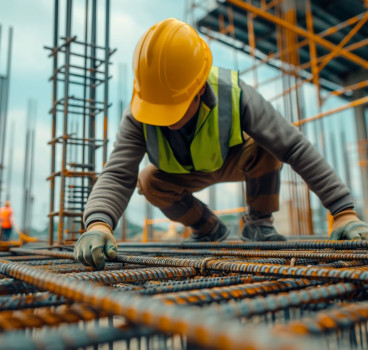Addressing the issue of overheating in buildings - a global perspective
As the world deals with the intensifying effects of climate change, the issue of overheating in dwelling units has become a pressing concern for governments, construction professionals and residents alike. With rising global temperatures and increasingly frequent heatwaves, ensuring that buildings remain safe and habitable is no longer optional - it’s essential, writes John Ridgeway.
The Canadian Board for Harmonised Construction Codes (CBHCC) has already taken a decisive step to address this issue by proposing a new change to the National Building Code of Canada (NBC). The public is being invited to participate in a public review of this proposed change, marking a critical opportunity for stakeholders to shape the future of building standards in the country. But what does this change mean and how does it fit into the global context of managing overheating in residential buildings?
Overheating in homes is a growing problem worldwide. Factors such as poorly insulated buildings, excessive use of glass facades, urban heat islands and inadequate ventilation systems have made many dwellings unbearably hot during summer months. In Canada, where traditionally cold climates dominate, older building designs often prioritise heat retention, inadvertently exacerbating overheating during warmer seasons.
The consequences of overheating go beyond discomfort. They include health risks from prolonged exposure to high indoor temperatures. These can lead to heat-related illnesses, particularly among vulnerable populations such as the elderly children, and those with pre-existing health conditions.
Furthermore, the reliance on air conditioning to combat overheating increases energy consumption, putting strain on energy grids and contributing to higher greenhouse gas emissions. Overheated homes can also negatively impact sleep, productivity and overall quality of life.
Recognising these challenges, countries worldwide are reevaluating their building codes to incorporate measures that mitigate overheating risks. The proposed change to the NBC by the CBHCC aims to establish specific guidelines and standards to prevent overheating in residential buildings. While the full details of the proposed amendment are still under review, the focus will likely include passive cooling strategies which encourage the use of natural ventilation, shading devices and building orientation to reduce heat buildup.
Setting limits on indoor temperatures during heatwaves and improving insulation standards to maintain a stable indoor climate year-round are also likely to be introduced together with the use of reflective or light-coloured roofing and exterior materials to minimise heat absorption.
By inviting public participation, the CBHCC ensures that the proposed change is not only effective, but also reflective of the needs and experiences of Canadians across the country. The inclusion of these changes in the 2025 edition of the National Model Codes will mark a significant step forward in making Canadian homes more resilient to climate change.
Global efforts to address overheating
Canada’s initiative aligns with a broader global movement to adapt building standards to combat overheating. The UK introduced its Future Homes Standard, which includes overheating mitigation as a key component. Recent updates to Part O of the Building Regulations require developers to conduct overheating risk assessments for new homes. These regulations prioritise passive design features, such as external shading and cross-ventilation, over mechanical cooling systems to ensure energy efficiency.
Under the EU’s Energy Performance of Buildings Directive (EPBD), member states are required to integrate strategies for climate resilience into their national building codes. The directive promotes passive design solutions, green roofs and advanced energy-efficient technologies to reduce the impact of heatwaves on buildings.
Australia’s National Construction Code (NCC) includes provisions for thermal comfort, focusing on insulation, glazing, and shading. The country has also embraced the use of climate-specific design principles to ensure that homes remain liveable in both hot and cold regions.

Singapore’s Green Mark Certification Scheme sets stringent requirements for thermal performance in buildings. The city-state leverages its tropical climate by implementing urban greenery, reflective surfaces and advanced cooling systems to combat overheating.
Despite these efforts, several challenges persist in addressing overheating. Many existing homes were not designed with overheating in mind, making retrofitting expensive and logistically complex. In addition, tight insulation and energy-efficient designs can sometimes trap heat, exacerbating the problem. We can also see that building occupants and developers may not fully understand the risks of overheating or the importance of implementing preventative measures. Incorporating advanced cooling solutions or passive design features may also increase upfront costs, which can deter developers and homeowners.
The CBHCC’s proposed change takes a holistic approach to mitigate overheating. By prioritising public engagement through the review process, the board can gather insights from diverse stakeholders, including architects, builders and residents, to create a well-rounded solution.
Additionally, the focus on incorporating passive design strategies ensures that the guidelines are not only effective, but also cost-efficient and sustainable. By leveraging local expertise and aligning with global best practices, Canada has the opportunity to establish itself as a leader in climate-adaptive building design.
The role of technology
Technology is also playing an increasingly important role in combating overheating in buildings. Innovations such as smart thermostats, automated shading systems and predictive climate modelling enable homeowners and developers to anticipate and respond to overheating risks effectively.
Moreover, tools like Building Information Modelling (BIM) allow architects and engineers to simulate temperature variations and optimise designs for thermal comfort before construction begins. By integrating these technologies into building codes, countries can ensure that new developments are future-proofed against rising temperatures.
However, addressing overheating in buildings is not just about improving comfort - it’s a vital step toward achieving broader sustainability goals. Reducing reliance on air conditioning can significantly lower energy consumption and greenhouse gas emissions, contributing to global efforts to combat climate change. Additionally, creating thermally comfortable homes can enhance public health, particularly for vulnerable populations who are disproportionately affected by extreme heat.
One of the most remarkable aspects of the CBHCC’s initiative is the emphasis on public engagement. By opening the review process to the broader community, the CBHCC is empowering Canadians to take an active role in shaping the future of their built environment. This participatory approach not only enhances the legitimacy of the proposed changes. but also ensures that the guidelines reflect the lived experiences and needs of diverse stakeholders.
Communities often possess unique insights into how overheating affects daily life, particularly in regions where rising temperatures are a newer phenomenon. For example, residents in cities may highlight challenges related to urban heat islands and limited access to green spaces, which exacerbate overheating.
Homeowners in rural settings might emphasise the importance of passive cooling techniques that are affordable and accessible in remote locations. Input from these groups can help ensure that solutions are equitable and do not disproportionately burden vulnerable populations with higher costs.
Builders and developers also play a crucial role in implementing solutions to overheating. The proposed changes to the NBC provide an opportunity for the construction industry to embrace innovation and lead the way in sustainable building practices.
The upcoming changes to Canada’s NBC represent a pivotal moment in the evolution of building standards. As climate change continues to reshape our environment, building codes must remain dynamic and forward-thinking to address emerging challenges.
In the future, we can expect building standards to evolve using localised climate models to tailor building codes to specific regional conditions. Aligning overheating mitigation with broader sustainability objectives, such as achieving net-zero carbon emissions in the construction sector, are also likely to be introduced.
We will also need to provide financial incentives for developers who adopt cutting-edge solutions to enhance thermal comfort and energy efficiency, as well as sharing best practices and research across borders to create a unified approach to overheating mitigation.
The issue of overheating in dwelling units is a global challenge that requires a collective response. From governments and industry professionals to individual homeowners, everyone has a role to play in creating safe, comfortable and sustainable living environments.
Canada’s initiative to address overheating through the proposed changes to the NBC is a testament to the country’s commitment to building resilience in the face of climate change. By participating in the public review process, Canadians can help shape a future where homes are not just places of shelter, but also sanctuaries of comfort and well-being – and perhaps we should be watching and learning from this process.
Additional Blogs

What Are Low-Carbon Concrete Options and How Are They Used?
Concrete is a staple product in the construction industry. However, its long-term use has proven just how much it's holding back the sector from minimizing its carbon footprint. You may have heard...
Read moreWhat the UK can learn from global construction tech leaders
The UK construction sector stands at a critical crossroads. Mounting pressures - stagnant productivity, acute labour shortages, tightening safety requirements, ambitious carbon-reduction targets and...
Read more

Are architects losing their influence in the digital era?
For decades, architects have been the central creative force in construction, shaping the buildings we see and the way projects are conceived, communicated and delivered. Their role has been...
Read more